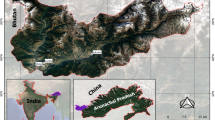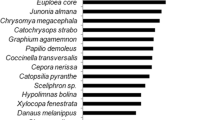Abstract
Acanthus ilicifolius is a spiny semi-woody evergreen shrub which is one of the most dominant species associated with mangrove communities. Although its floral biology is well documented, there are only a few systematic and exhaustive studies of floral visitors of this species. Successful plant reproduction is highly dependent on plant-pollinator interaction. The present study aims to understand the range of floral visitors of A. ilicifolius and their spatio-temporal variation in visitation pattern from the Indian Sundarbans. This study was conducted within five islands of Sundarbans Biosphere Reserve (SBR), namely, Bali, Gosaba, Satjelia, Gangasagar and Bakkhali during 2015 and 2016. Fifteen flower foragers under five taxonomic orders, i.e., Hymenoptera, Coleoptera, Diptera, Lepidoptera and Passeriformes were identified. Seven out of these fifteen species were reported for the first time as floral visitors of A. ilicifolius. Hymenopterans constituted about 50% of the floral visitors observed. However, Micraspis discolor of the order Coleoptera, with a relative abundance of about 32%, constituted the dominant floral visitor species of A. ilicifolius. Apis mellifera, constituting about 23%, was the dominant Hymenopteran flower visitor species. Although Gangasagar and Bakkhali being tourist spots, and facing greater anthropogenic interference, they had the highest abundance of floral visitors. A significant variation in floral visitor abundance was observed across different time of the day throughout the study period. Floral visitors were most abundant in the morning between 8 am to 12 pm. This study provides the first comprehensive report of diversity and abundance of the floral visitors and their visitation pattern on A. ilicifolius.
Implications for insect conservation
Proper documentation of the visitation pattern and foraging behaviour is important for conserving floral visitors of A. ilicifolius. Since this is the most dominant minor mangrove species, A. ilicifolius can help attract pollinators from surrounding areas, improving the pollinator abundance in other co-flowering species. Thus, conserving the entire mangrove ecosystem.







Similar content being viewed by others
References
Abdel-Galel R, Elbanna S, Semida F (2021) Foraging rhythm of honeybees Apis mellifera in Ismailia Egypt. Catrina Int J Environ Sci 23(1):27–33. https://doi.org/10.21608/CAT.2021.196712
Akter A, Biella P, Batary P, Klecka J (2020) Changing pollinator communities along a disturbance gradient in the Sundarbans mangrove forest: a case study on Acanthus ilicifoliusA. ilicifolius and Avicennia officinalis. Global Ecol Conserv 24:e01282. https://doi.org/10.1016/j.gecco.2020.e01282
Aluri JSR (1990) Observations on the floral biology of certain mangroves. Proc Indian Natl Sci Acad Part B Biol Sci 56(4):367–374
Aluri JSR, Bethapudi R, Chappidi PR (2017) Reproductive ecology of Acanthus ilicifoliusA. ilicifolius L., a non-viviparous mangrove associate in coringa mangrove forest, Andhra Pradesh (India). Transylv Rev Syst Ecol Res 19(3):17. https://doi.org/10.1515/trser-2017-0018
Arjitha KV, Thomas J, Therattil JJ (2014) A study on diversity and distribution of insects in Chettuvai Mangroves, Kerala. Millenn Zool 15(1):47–4
Azmi W, Zulqurnain NS, Ghazi R (2015) Melissopalynology and foraging activity of stingless bees, Lepidotrigona terminata (Hymenoptera: Apidae) from an apiary in Besut, Terengganu. J Sustain Sci Manage 10:27–35. https://jssm.umt.edu.my/wp-content/uploads/sites/51/2015/06/3.pdf
Belavadi VV, Ganeshaiah KN (2013) Insect pollination manual. Department of Agricultural Entomology University of Agricultural Sciences, Bangalore, New Delhi
Chakrabarty S, Chatterjee T, Gaine T, Bhattacharjee S, Chaudhuri P (2022) Vegetative and reproductive phenology of dominant mangrove species: a multi-parametric approach from indian Sundarbans. Unpublished Manuscript
Chakraborti U (2019) Diversity of insect flower visitors and their role in pollination of True Mangrove Plants in Sundarban Biosphere Reserve, India. Unpublished Thesis, University of Kalyani
Chakraborti U, Mitra B, Bhadra K (2019) Diversity and ecological role of Insect Flower Visitors in the pollination of Mangroves from the indian Sundarbans. Curr Sci 117(6):1060–1070. https://doi.org/10.18520/cs/v117/i6/1060-1070
Chowdhury A, Sanyal P, Maiti SK (2016) Dynamics of mangrove diversity influenced by climate change and consequent accelerated sea level rise at indian Sundarbans. Int J Glob Warm 9(4):486–506. https://doi.org/10.1504/IJGW.2016.076333
Danda A, Joshi A, Ghosh A, Saha R (2017) State of art report on biodiversity in indian Sundarbans. World Wide Fund for Nature-India, New Delhi. http://support.wwfindia.org/other/State_of_Art_Report.pdf
Giri S, Mukhopadhyay A, Hazra S, Mukherjee S, Roy D, Ghosh S, Ghosh T, Mitra D (2014) A study on abundance and distribution of mangrove species in indian Sundarban using remote sensing technique. J Coast Conserv 18(4):359–367. https://doi.org/10.1007/s11852-014-0322-3
González AV, Murúa M, Ramírez PA (2014) Temporal and spatial variation of the pollinator assemblages in Alstroemeria ligtu (Alstroemeriaceae). Revista Chil de Historia Nat 87(1):5. https://doi.org/10.1186/0717-6317-87-5
Halsch CA, Shapiro AM, Fordyce JA, Nice CC, Thorne JH, Waetjen DP, Forister ML (2021) Insects and recent climate change. Proc Natl Acad Sci 118(2):200
Herrera CM (1990) Daily patterns of pollinator activity, differential pollinating effectiveness, and floral resource availability, in a summer-flowering Mediterranean Shrub. Oikos 58(3):277–288. https://doi.org/10.2307/3545218
Hung KJ, Kingston JM, Albrecht M, Holway DA, Kohn JR (2018) The worldwide importance of honey bees as pollinators in natural habitats. Proc Biol Sci 285(1870):20172140. https://doi.org/10.1098/rspb.2017.2140
Jonathan JK, Kulkarni PP, Tikader BK (1986) Manual, collection, preservation, and identification of insects and mites of economic importance. Zoological Survey of India, Calcutta
Kato M, Kawakita A (2004) Plant-pollinator interactions in New Caledonia influenced by introduced honey bees. Am J Bot 91(11):1814–1827. https://doi.org/10.3732/ajb.91.11.1814
Knop E, Gerpe C, Ryser R, Hofmann F, Menz MHM, Trosch S, Ursenbacher S, Zoller L, Fontaine C (2018) Rush hours in flower visitors over a day-night cycle. Insect Conserv Divers 11(3):267–275. https://doi.org/10.1111/icad.12277
Mitra B, Chakraborti U, Biswas O, Roy S, Mallick K, Das P (2016) First record of Batocera rufomaculata (De Geer, 1775) from Sunderban biosphere reserve, West Bengal. Int J Entomol Res 2016a 1(3):31–32. http://www.entomologyjournals.com/archives/2016/vol1/issue3/1-2-18
Moeller DA (2004) Facilitative interactions among plants via shared pollinators. Ecology 85(12):3289–3301
NASA (2022) POWER|Data Access Viewer. https://power.larc.nasa.gov/data-access-viewer/. Accessed 10 June 2022
Naskar K, Mandal R (1999) Ecology and biodiversity of indian mangroves. Daya Books, Darya Ganj
Newman DA, Thomson JD (2005) Interactions among nectar robbing, floral herbivory, and ant protection in Linaria vulgaris. Oikos 110(3):497–506. https://doi.org/10.1111/j.0030-1299.2005.13885.x
Primack RB, Duke NC, Tomlinson P (1981) Floral morphology in relation to pollination ecology in five Queensland coastal plants. Austrobaileya 1(4):346–355. https://www.jstor.org/stable/41738619
Pothiraj C, Balaji P, Shanthi R, Gobinath M, Babu RS, Munirah AAD, Ashraf AH, Kumar KR, Veeramanikandan V, Arumugam R (2021) Evaluating antimicrobial activities of Acanthus ilicifolius L. and Heliotropium curassavicum L against bacterial pathogens: an in-vitro study. J Infect Public Health 14(12):1927–1934
Rader R, Edwards W, Westcott DA, Cunningham SA, Howlett BG (2013) Diurnal effectiveness of pollination by bees and flies in agricultural Brassica rapa: implications for ecosystem resilience. Basic Appl Ecol 14(1):20–27. https://doi.org/10.1016/j.baae.2012.10.011
Reddi SC, Aluri JSR (1997) Reproductive biology of three mangrove plant species. Indian J For 20(2):153–157. https://www.researchgate.net/publication/258997600_Reproductive_biology_of_three_mangrove_plant_species
Remadevi OK, Latheef CA, Chatterjee D, Raji B (2008) Entomofauna of mangrove ecosystem of India an annotated check list. Biosystematica 2(2):33–80
Roy M, Panja B, Das A, Mitra B (2018) First report of mangrove inhabiting ants from Bajkul forest range of Purba Medinipur district, West Bengal. Pharma Innov J 7(11):81–82
Santhiavalli P, Jayanthi G (2016) A study on the anatomical characteristics of Acanthus illicifolius Linn. Eur J Pharm Med Res 3(9):354–361. https://www.ejpmr.com/home/abstract_id/1483
Saranya A, Ramanathan T, Kesavanarayanan KS, Adam A (2015) Traditional medicinal uses, chemical constituents and biological activities of a mangrove plant, Acanthus ilicifolius linn. A brief review. Am Eurasian J Agric Environ Sci 15:243–250. https://doi.org/10.5829/idosi.aejaes.2015.15.2.12529
Senapati B, Satpathy J (1983) The seedling fly, Atherigona oryzae Malloch as a pest of rice in Orissa (India). J Entomol Res 7(1):77–79. https://www.cabi.org/isc/abstract/19840518223
Shanker C, Mohan M, Sampathkumar M, Lydia C, Katti G (2013) Functional significance of Micraspis discolor (F.) (Coccinellidae: Coleoptera) in rice ecosystem. J Appl Entomol 137(8):601–609. https://doi.org/10.1111/jen.12035
Sharief Mohammad N, Geneto M, Abateneh DD, Salahuddin M, Manzar MD, UMR V (2017) Extraction of secondary metabolites from roots of acanthus ilicifolius l and screening for antioxidant and antibacterial activity. Int J Pharm Sci Invent 6(2):31–36
Singh D, Aeri V (2013) Phytochemical and pharmacological potential of Acanthus ilicifoliusA. ilicifolius. J Pharm Bioallied Sci 5(1):17–20. https://doi.org/10.4103/0975-7406.106557
Therattil J, Olakkengil JL (2011) Diversity and distribution of destructive insects in Chettuvai Mangroves, Kerala, India. Millennium Zool 12(1):35–37
Therattil JJ (2017) Role and Interaction of insect pests in mangrove vegetations of central Kerala. Int J Appl Res 3(3(S)):262–264
Tomlinson PB (2016) The botany of mangroves. Cambridge University Press, Cambridge. https://doi.org/10.1017/cbo9781139946575
Velmani S, Perumal B, Santhosh C, Vetrivel C, Maruthupandian A (2016) Phytochemical and traditional uses on Acanthus ilicifoliusA. ilicifolius (L). J Adv Appl Sci Res 1(3):43–48. https://doi.org/10.46947/joaasr13201617
Verma P, Shah M (2020) Acanthus ilicifoliusA. ilicifolius: a true mangrove with biomedical potential. World J Pharm Pharm Sci 9:472–489. https://doi.org/10.20959/wjpps202011-17428
Acknowledgements
Authors are grateful to the Director of Zoological Survey of India, Kolkata, for his necessary support. Authors also thank all the locals of the study areas of Sundarbans Biosphere Reserve for their intermittent support. This research did not receive any specific grant from funding agencies in the public, commercial, or not-for-profit sectors.
Funding
The authors did not receive financial support from any organization for the submitted work. No funds, grants, or other support was received. No funding was received for conducting this study. No funding was received to assist with the preparation of this manuscript. The authors have no relevant financial or non-financial interests to disclose.
Author information
Authors and Affiliations
Contributions
TC: Conceptualization, Methodology, Supervision, Investigation, Formal analysis, Visualization, Validation, Writing - original draft, Writing - review & editing; SC (Equal contribution): Investigation, Data curation, Visualization, Software, Writing - original draft, Writing - review & editing; SR: Investigation, Methodology, Data curation; OB: Investigation, Data curation, Methodology; BM: Conceptualization, Supervision, Project administration, Resources, PC: Conceptualization, Supervision.
Corresponding author
Ethics declarations
Conflict of interest
The authors have no competing interests to declare that are relevant to the content of this article. All authors certify that they have no affiliations with or involvement in any organization or entity with any financial interest or non-financial interest in the subject matter or materials discussed in this manuscript. The authors have no financial or proprietary interests in any material discussed in this article.
Additional information
Publisher’s Note
Springer Nature remains neutral with regard to jurisdictional claims in published maps and institutional affiliations.
Supplementary Information
Below is the link to the electronic supplementary material.
Rights and permissions
Springer Nature or its licensor (e.g. a society or other partner) holds exclusive rights to this article under a publishing agreement with the author(s) or other rightsholder(s); author self-archiving of the accepted manuscript version of this article is solely governed by the terms of such publishing agreement and applicable law.
About this article
Cite this article
Chatterjee, T., Chakrabarty, S., Roy, S. et al. Spatial and temporal variation of floral visitors and their visitation pattern on Acanthus ilicifolius L.: a case study from the mangrove ecosystem of Indian Sundarbans. J Insect Conserv 27, 493–503 (2023). https://doi.org/10.1007/s10841-023-00472-0
Received:
Accepted:
Published:
Issue Date:
DOI: https://doi.org/10.1007/s10841-023-00472-0




